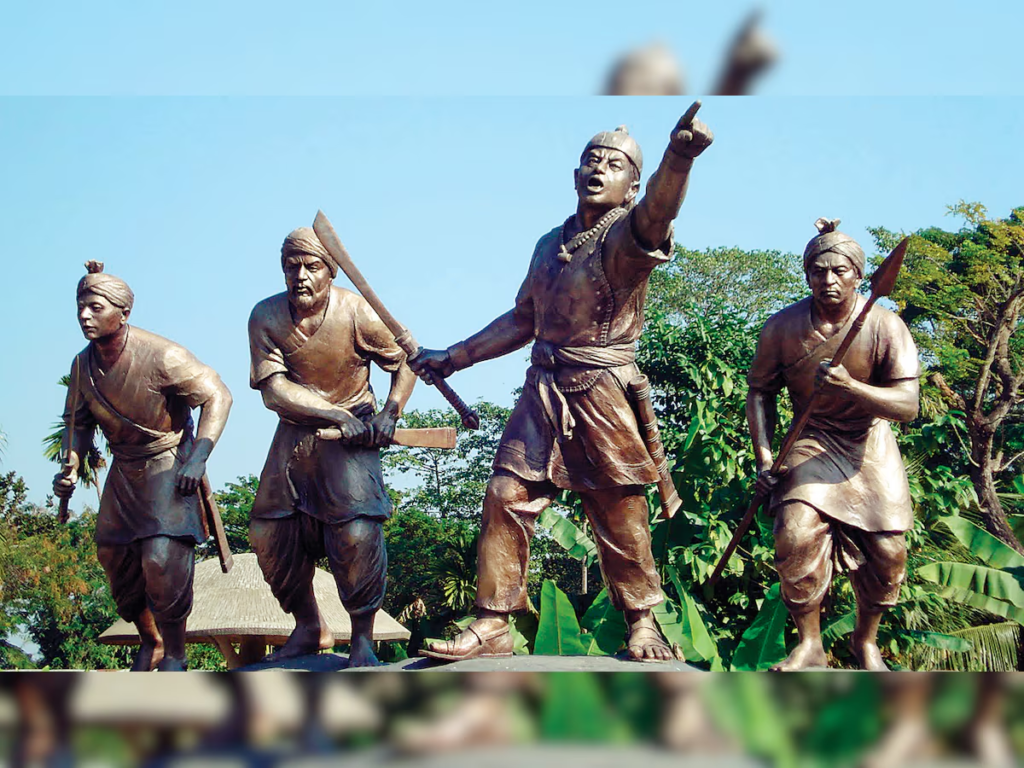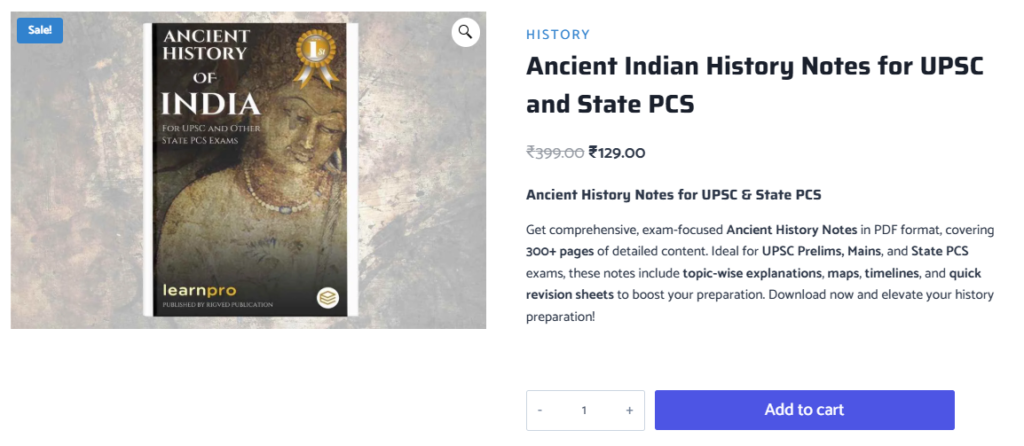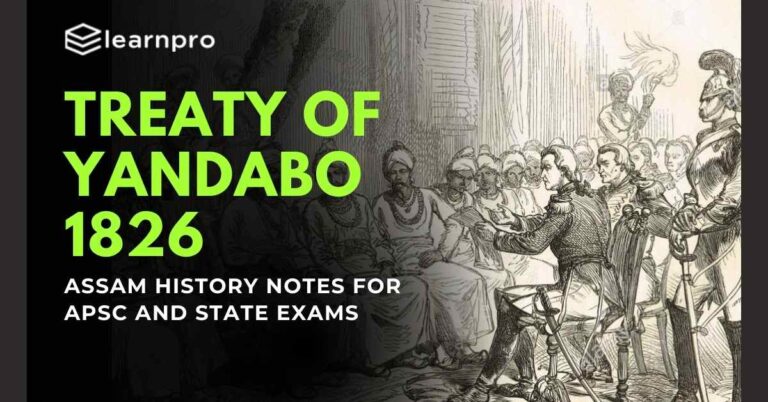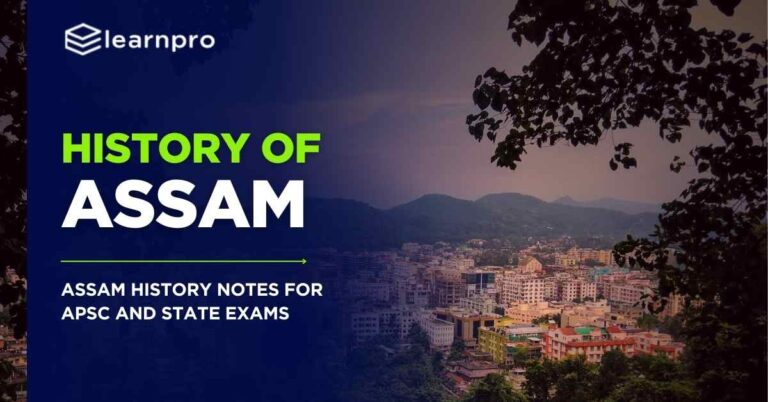October 25, 2025 12:26 pm
Introduction of Moamoria Rebellion
The Moamoria Rebellion in Assam stands as a powerful testament to the simmering unrest that once challenged the hegemony of the Ahom Dynasty in 18th-century Assam. This socio-religious uprising, led by the Moamorias — devout followers of the Mayamara Satra, marked one of the earliest expressions of class and caste-based dissent in the northeastern region of India.
Far from being a mere power struggle, the Moamoria Rebellion in Assam was deeply rooted in systemic exploitation, social discrimination, and religious suppression. The Ahom rulers, who had maintained a long-standing autocratic regime, imposed the rigid Paik labor system, under which commoners were subjected to forced, unpaid labor in royal and military services. The Moamorias, primarily from marginalized tribal and backward castes, were excluded from the ruling structures and faced constant persecution for their non-Brahminical spiritual beliefs.

The rebellion erupted in full force in 1769 and shook the very foundations of Ahom rule. The rebels not only posed a formidable military challenge but also briefly captured the Ahom capital, Rangpur. Although the rebellion saw multiple phases, each brutally repressed, its cumulative impact was transformative — weakening the monarchy and inviting external intervention from the Burmese and eventually the British.
Understanding the Moamoria Rebellion in Assam is crucial not just from a historical lens but as a lens through which to view early resistance movements that advocated egalitarian values, spiritual freedom, and social justice in India. This uprising offers a critical perspective on how socio-religious movements, when marginalized, can evolve into full-fledged rebellions capable of altering the course of history.
- APSC Notification 2025 OUT | APSC CCE 2025 Exam Date, Vacancy, Exam Pattern, Syllabus & Eligibility
- APSC Exam 2025: A Complete Guide for Aspirants
- APSC CCE Final Result 2023: Assam Public Service Commission Declares Results for Combined Competitive Examination
- APSC Result 2025: Date, Download PDF, and Merit List
- APSC Application Form 2025: Expected Release Date , How to Apply
- APSC Cut Off 2025: Expected Cut off, Everything You Need to Know
- APSC Exam 2025: Key Dates, Eligibility, Admit Card, Syllabus, and Exam Pattern
- APSC Syllabus 2025: Subject-Wise Topics for APSC Prelims, Mains, and Interview
📚 Historical Background of the Moamoria Rebellion in Assam
To truly grasp the roots of the Moamoria Rebellion in Assam, one must first understand the socio-political landscape of Assam under the Ahom dynasty. The Ahoms, originally of Tai origin, arrived in the Brahmaputra Valley in the early 13th century and gradually established a kingdom that lasted for nearly 600 years. Over time, they assimilated into Assamese culture but maintained a highly centralized, hierarchical society dominated by aristocratic clans and a rigid administrative framework.

The Ahom administration was based on the Paik system, a form of compulsory labor where every male was registered as a paik (laborer or soldier) and had to serve the state for fixed periods. While efficient from a governance perspective, this system disproportionately affected the lower strata of society, especially tribal and marginalized communities. It became one of the key instruments of economic oppression, breeding discontent among the masses.
During the 17th and 18th centuries, Mayamara Satra, a liberal offshoot of Neo-Vaishnavism founded by Aniruddhadeva, gained prominence among lower caste and tribal groups. This satra emphasized equality, spiritual devotion, and social justice — principles that directly contradicted the elitist and hierarchical norms upheld by the Ahom elite. The Moamorias, ardent followers of this movement, were increasingly seen as a threat by the orthodox Ahom rulers.
The Moamorias were subjected to systemic persecution: they were denied administrative positions, their satras were often vandalized, and their religious practices suppressed. The antagonism between the Ahom monarchy and the Mayamara followers intensified, and by the mid-18th century, tensions had reached a boiling point.
It is also essential to note that the Ahom empire during this period was riddled with internal decay — succession crises, over-expansion, and increasing corruption weakened its structure. These vulnerabilities made it easier for organized resistance to emerge.
Thus, the Moamoria Rebellion in Assam did not arise in a vacuum. It was the product of systemic religious discrimination, economic exploitation, and caste-based exclusion in a decaying imperial setup. The rebellion became a convergence point for multiple suppressed communities who rallied under the banner of the Mayamara Satra to demand justice, dignity, and a reimagining of power dynamics.
Causes of the Moamoria Rebellion in Assam
The Moamoria Rebellion in Assam did not erupt spontaneously — it was the outcome of deep-seated socio-religious tensions, sustained economic burdens, and centuries of systemic marginalization. These elements collectively galvanized the Moamorias into one of the most significant anti-feudal uprisings in Assamese history.
1️⃣ Religious Discrimination
At the heart of the Moamoria Rebellion in Assam lay the issue of religious oppression. The Moamorias were followers of the Mayamara Satra, a reformist Vaishnavite sect that emerged as a reaction to Brahmanical orthodoxy and the exclusivist policies of the Ahom court. The sect’s founder, Aniruddhadeva, advocated spiritual inclusivity, allowing entry to tribal people, lower castes, and women — all of whom were generally excluded from mainstream Brahmanical rituals.
However, the Ahom rulers, influenced by upper-caste clergy, perceived this movement as subversive. The Moamoria Satras were frequently targeted: monks were tortured, monasteries desecrated, and their leaders ostracized. Even revered religious figures from the community were denied basic respect or political representation. This consistent suppression of their spiritual identity sowed the seeds of a deeply religiously motivated rebellion.
2️⃣ Economic Exploitation
Another major driver behind the Moamoria Rebellion in Assam was the exploitative Paik system, which formed the economic backbone of the Ahom administration. Under this system, commoners were enrolled as paiks, compelled to render free labor in state projects — from building embankments to fighting wars — without adequate compensation or relief. Over time, the burden of service grew disproportionate, particularly on the non-elite classes, which included the Moamorias.
Land distribution was also deeply skewed. Royal officers and aristocrats held vast tracts of fertile land, while the Moamorias and other lower-class groups struggled for subsistence. Taxation was often arbitrary and cruelly enforced, exacerbating rural distress. For a community already under spiritual attack, these economic hardships were unbearable and triggered mass unrest.
3️⃣ Social Marginalization
In addition to religious and economic factors, social exclusion played a vital role in the Moamoria uprising. The Ahom court followed a strict caste and status hierarchy, where administrative and military roles were largely reserved for the nobility or upper-caste elites. Moamorias, despite being skilled, disciplined, and deeply organized, were denied access to these positions.
Moreover, incidents of public humiliation of Moamoria leaders, denial of dignified funerals, and exclusion from community rituals and public resources created a climate of humiliation and hostility. These indignities served as powerful motivators for rebellion, especially among the younger generation of Moamorias who sought honor and justice.
Together, these interwoven causes formed a potent catalyst. The Moamoria Rebellion in Assam was not merely a revolt against a monarchy — it was an uprising of the excluded, the devout, and the dispossessed against systemic injustice.
Course of the Moamoria Rebellion in Assam
The Moamoria Rebellion in Assam unfolded not as a single event but as a protracted, multi-phased uprising spanning over half a century. It witnessed waves of rebellion, temporary victories, brutal retaliations, and political upheavals that nearly dismantled the Ahom monarchy.
The First Phase (1769–1770): The Spark
The rebellion began in 1769 during the reign of Ahom king Lakshmi Singha. Fueled by accumulated grievances, the Moamorias launched their first major offensive by mobilizing peasants, tribal allies, and discontented soldiers. The rebellion initially took shape in Upper Assam, especially around Majuli, the spiritual heartland of the Mayamara Satra.
In a daring move, the Moamoria forces attacked Rangpur, the Ahom capital. They defeated the royal army, captured the king, and installed Ragh Neog, one of their prominent leaders, as a temporary ruler. This marked the first instance in Assam’s history where a non-royal and non-upper caste figure occupied the seat of power.
➡️ This phase shook the aristocracy and revealed the vulnerability of the Ahom establishment.
The Second Phase (1780s): Guerrilla Warfare and Tactical Resistance
Although the Ahoms managed to temporarily suppress the rebellion by executing rebel leaders and destroying Moamoria strongholds, the resistance resurfaced in the 1780s, this time with more widespread support. The Moamorias adopted guerrilla warfare, attacking military outposts, sabotaging supply routes, and gaining control over strategic river routes.
Their tactics were deeply rooted in the terrain knowledge of the Brahmaputra valley — they exploited Assam’s wetlands, hills, and forests to escape and regroup quickly. Despite repeated campaigns, the Ahoms were unable to decisively crush the rebellion.
➡️ The rebellion’s longevity was made possible by mass participation and decentralized leadership.
Temporary Moamoria Rule: Establishing a Parallel Governance
By 1786, the Moamorias had once again seized Rangpur and established their own administration, challenging the legitimacy of the Ahom monarchy. This interim rule lasted nearly five years, during which Moamoria leaders sought to:
- Abolish the oppressive paik system
- Restore confiscated land to peasants
- Encourage egalitarian religious practices
However, the lack of formal governance experience and internal factionalism weakened their grip. Their power was soon challenged not just by Ahom loyalists but also external players like the Burmese.
Final Suppression and Aftermath (1794–1805)
By the late 1790s, the Ahom monarchy, under the leadership of Purnananda Burhagohain, launched a full-scale military campaign to crush the rebellion once and for all. With the help of mercenaries and brutal force, the Moamorias were finally subdued around 1805.
Thousands were executed or exiled. Several Mayamara monasteries were razed, and the movement was pushed underground. However, the cost of victory was immense — the Ahom kingdom was severely weakened, setting the stage for Burmese invasions and eventual British annexation of Assam in the early 19th century.
Enduring Influence
Despite its military defeat, the Moamoria Rebellion in Assam left a profound legacy:
- It decentralized power and fractured Ahom unity
- It introduced religious pluralism into Assam’s political discourse
- It sowed the seeds for future peasant revolts and regional identity assertions
The rebellion is remembered not just for its intensity but for its vision of an inclusive and egalitarian Assamese society.
Aftermath and Impact of the Moamoria Rebellion in Assam
The Moamoria Rebellion in Assam may have ended in suppression, but its consequences were far-reaching, reshaping the state’s political trajectory, religious fabric, and class equations. What began as a socio-religious uprising soon transformed into a defining event that destabilized the Ahom monarchy and opened the floodgates for external invasion and colonial dominance.
Political Consequences: Decline of the Ahom Monarchy
One of the most profound impacts of the Moamoria Rebellion in Assam was the irreversible weakening of Ahom rule. The rebellion exposed the monarchy’s fragility — it had lost both legitimacy and control over large parts of its territory. The financial and military resources spent in suppressing the rebellion drained the royal treasury.
In the aftermath, the Ahom kingdom fractured into warring factions. Nobles vied for influence, and power struggles became endemic, leading to a paralysis in governance. This vacuum in authority would later attract Burmese invasions (1817–1826), which devastated Assam, culminating in British annexation following the Treaty of Yandabo in 1826.
➡️ In essence, the Moamoria Rebellion in Assam initiated the collapse of a 600-year-old dynasty.
Religious Transformation: Rise of Inclusive Vaishnavism
Though crushed militarily, the Mayamara Satra movement gained newfound respect after the rebellion. The uprising forced the ruling elite to reconsider their attitude toward religious pluralism. In later years, other satras modeled after Mayamara teachings began receiving recognition, and sectarian violence diminished.
The rebellion brought to the forefront the clash between orthodoxy and reform, compelling Assamese society to embrace more egalitarian spiritual values. While the monarchy tried to reassert Brahmanical dominance post-rebellion, Neo-Vaishnavism continued to spread among the rural masses, keeping the spirit of Moamoria resistance alive in cultural memory.
Economic Fallout: Collapse of the Paik System
The prolonged rebellion wreaked havoc on Assam’s agrarian economy. The destruction of croplands, mass displacements, and loss of skilled labor crippled agricultural production. The once-efficient Paik labor system became unsustainable due to a sharp decline in manpower and trust in the royal system.
In response, the Ahom rulers were forced to introduce reforms and loosen central control, granting greater autonomy to local chieftains. However, these changes came too late to restore the kingdom’s original strength.
Strategic Shift: Entry of Foreign Powers
Perhaps the most geopolitically significant impact of the Moamoria Rebellion in Assam was that it paved the way for foreign interference. Observing the region’s internal instability, the Burmese saw an opportunity to expand their influence. They invaded Assam multiple times, exploiting the fractured political state.
Eventually, British East India Company forces intervened to expel the Burmese. By 1826, Assam was annexed by the British, making it a part of their empire. The rebellion, thus, can be seen as the first domino in Assam’s colonial transition.
Legacy in Assamese Consciousness
Though often overshadowed in mainstream Indian history, the Moamoria Rebellion in Assam occupies a central place in the state’s regional identity. It is remembered not just as a revolt, but as an assertion of dignity by the marginalized, a spiritual call for equality, and a prototype for peasant movements that followed in later centuries.
Significance of the Moamoria Rebellion in Assam
The Moamoria Rebellion in Assam holds immense significance, not just within the confines of regional history, but as a landmark movement that prefigured many later anti-colonial and anti-feudal uprisings in India. Its philosophical undertones, grassroots mobilization, and resistance to state oppression render it a precursor to modern social revolutions.
Assertion of Egalitarianism
At its core, the Moamoria Rebellion in Assam was a fight for equality — spiritual, social, and political. Unlike many uprisings led by disgruntled elites or external invaders, this rebellion emerged from the lowest rungs of society: tribal groups, peasants, and backward castes who were denied dignity under the Ahom regime.
The Mayamara Satra ideology that inspired the Moamorias was deeply egalitarian. It challenged caste hierarchy, rejected Brahmanical exclusivity, and empowered women and tribal followers to engage in religious practices — a radical stance in 18th-century India. The rebellion thus signaled early democratic consciousness, grounded in the cultural soil of Assam.
Prototype for Mass-Based Movements
The Moamoria Rebellion in Assam also pioneered the idea of a mass-based rebellion with spiritual backing. Unlike the more elite-led revolts like the Paika Rebellion (1817) or the Santhal Uprising (1855–56), the Moamoria movement grew organically from within society, mobilizing thousands across caste and ethnic lines.
Its structure — a decentralized command, reliance on guerrilla tactics, and local resourcefulness — became a blueprint for subsequent peasant and tribal revolts during both pre-colonial and colonial periods.
Regional Identity and Historical Reclamation
For Assam, the rebellion was a turning point in regional identity formation. It broke the myth of Ahom invincibility and emphasized that resistance could emerge from indigenous institutions like satras. Today, the movement is celebrated as an assertion of Assamese socio-political agency, long before the rise of organized nationalism.
While underrepresented in national textbooks, regional scholars and historians have increasingly reclaimed this rebellion as part of Assam’s proud legacy of resistance.
Comparative Significance
When viewed alongside other Indian uprisings — such as the Kol Rebellion, Santhal Rebellion, and the Indigo Revolt — the Moamoria Rebellion in Assam stands out for its fusion of religion and revolution. It didn’t merely seek material change; it aimed to redefine spiritual legitimacy and state morality.
In summary, the Moamoria Rebellion in Assam is significant not just because of what it destroyed — but because of what it stood for: justice, equality, and the right to dissent.
Historiography of the Moamoria Rebellion in Assam
The Moamoria Rebellion in Assam has not always received the scholarly attention it deserves — especially in mainstream Indian historiography. While the rebellion fundamentally altered Assam’s socio-political landscape, its representation has varied significantly based on perspective, context, and intention.
British Colonial Accounts: The “Savage Uprising” Narrative
British chroniclers, particularly those writing in the 19th century, viewed the Moamoria Rebellion in Assam through a colonial lens. For them, the rebellion represented yet another example of “oriental despotism” and tribal lawlessness, which justified British intervention and control.
Writers like Edward Gait in A History of Assam did acknowledge the rebellion’s scale but often downplayed its ideological roots. They portrayed it as a reactionary movement driven by revenge and anarchy, rather than a coherent challenge to oppression. This narrative, though flawed, influenced early academic discourse.
Assamese Historians: Rediscovering Regional Voices
From the mid-20th century onward, Assamese scholars began revisiting the Moamoria Rebellion in Assam with fresh eyes. Historians like Dr. Surya Kumar Bhuyan and Dr. S.K. Barpujari argued that the rebellion was a revolutionary movement, rooted in legitimate grievances and led by spiritually awakened leaders.
They emphasized that the Moamorias weren’t just rebels — they were visionaries fighting for socio-religious emancipation. This shift in interpretation re-centered the rebellion within Assam’s own historical consciousness.
Folk Narratives and Oral Traditions
Interestingly, in the rural heartlands of Assam, the Moamoria Rebellion lives on not in books, but in ballads, folktales, and oral histories. These narratives often celebrate rebel leaders as folk heroes, spiritual warriors who stood against tyranny and defended the dignity of the oppressed.
These stories provide a more emotional and grassroots understanding of the rebellion — one that connects the past to the lived experiences of present communities.
Conclusion: The Enduring Legacy of the Moamoria Rebellion in Assam
The Moamoria Rebellion in Assam was far more than a localized revolt against a declining monarchy — it was a defining expression of resistance, deeply rooted in spiritual conviction, social injustice, and a longing for equality. What makes this rebellion historically profound is its multi-dimensional nature: it was a spiritual awakening, an economic uprising, and a political revolution all at once.
The movement exposed the inherent weaknesses of the Ahom regime, ushered in a period of destabilization, and created conditions ripe for external invasions and colonial dominance. Yet, in its failure to achieve lasting political power, the Moamoria Rebellion succeeded in awakening Assam’s marginalized voices. It challenged feudal hierarchies, redefined religious legitimacy, and left behind an intellectual legacy that continues to inspire Assam’s cultural and historical consciousness.
Though often absent from national discourse, the Moamoria Rebellion in Assam deserves recognition as one of India’s earliest and most ideologically rich mass uprisings. Its story is not just about what was lost — but about the courage to demand a different, more equitable future.






